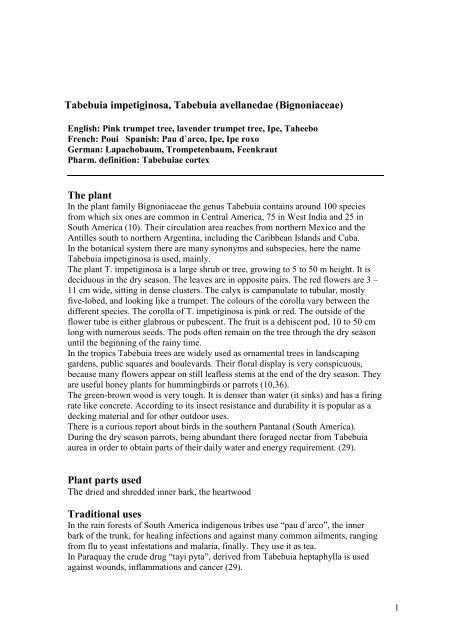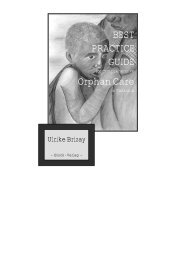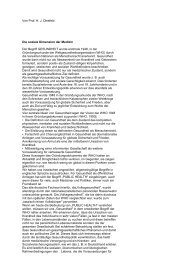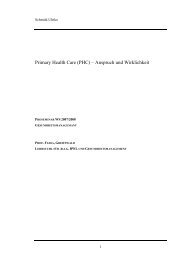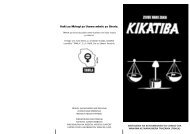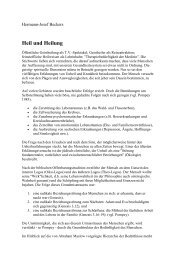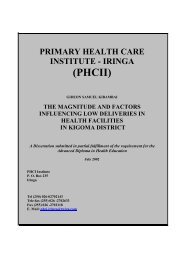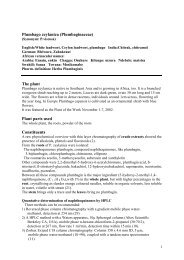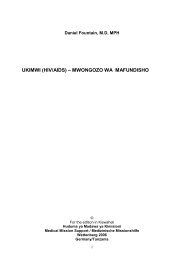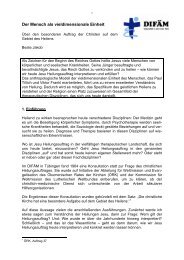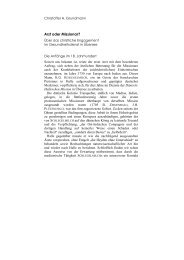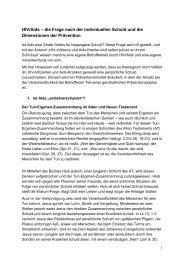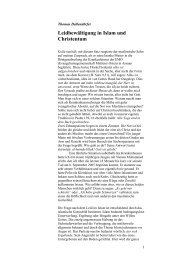Tabebuia impetiginosa, Tabebuia avellanedae ... - MMH/MMS
Tabebuia impetiginosa, Tabebuia avellanedae ... - MMH/MMS
Tabebuia impetiginosa, Tabebuia avellanedae ... - MMH/MMS
You also want an ePaper? Increase the reach of your titles
YUMPU automatically turns print PDFs into web optimized ePapers that Google loves.
<strong>Tabebuia</strong> <strong>impetiginosa</strong>, <strong>Tabebuia</strong> <strong>avellanedae</strong> (Bignoniaceae)<br />
English: Pink trumpet tree, lavender trumpet tree, Ipe, Taheebo<br />
French: Poui Spanish: Pau d`arco, Ipe, Ipe roxo<br />
German: Lapachobaum, Trompetenbaum, Feenkraut<br />
Pharm. definition: <strong>Tabebuia</strong>e cortex<br />
The plant<br />
In the plant family Bignoniaceae the genus <strong>Tabebuia</strong> contains around 100 species<br />
from which six ones are common in Central America, 75 in West India and 25 in<br />
South America (10). Their circulation area reaches from northern Mexico and the<br />
Antilles south to northern Argentina, including the Caribbean Islands and Cuba.<br />
In the botanical system there are many synonyms and subspecies, here the name<br />
<strong>Tabebuia</strong> <strong>impetiginosa</strong> is used, mainly.<br />
The plant T. <strong>impetiginosa</strong> is a large shrub or tree, growing to 5 to 50 m height. It is<br />
deciduous in the dry season. The leaves are in opposite pairs. The red flowers are 3 ñ<br />
11 cm wide, sitting in dense clusters. The calyx is campanulate to tubular, mostly<br />
five-lobed, and looking like a trumpet. The colours of the corolla vary between the<br />
different species. The corolla of T. <strong>impetiginosa</strong> is pink or red. The outside of the<br />
flower tube is either glabrous or pubescent. The fruit is a dehiscent pod, 10 to 50 cm<br />
long with numerous seeds. The pods often remain on the tree through the dry season<br />
until the beginning of the rainy time.<br />
In the tropics <strong>Tabebuia</strong> trees are widely used as ornamental trees in landscaping<br />
gardens, public squares and boulevards. Their floral display is very conspicuous,<br />
because many flowers appear on still leafless stems at the end of the dry season. They<br />
are useful honey plants for hummingbirds or parrots (10,36).<br />
The green-brown wood is very tough. It is denser than water (it sinks) and has a firing<br />
rate like concrete. According to its insect resistance and durability it is popular as a<br />
decking material and for other outdoor uses.<br />
There is a curious report about birds in the southern Pantanal (South America).<br />
During the dry season parrots, being abundant there foraged nectar from <strong>Tabebuia</strong><br />
aurea in order to obtain parts of their daily water and energy requirement. (29).<br />
Plant parts used<br />
The dried and shredded inner bark, the heartwood<br />
Traditional uses<br />
In the rain forests of South America indigenous tribes use ìpau d`arcoî, the inner<br />
bark of the trunk, for healing infections and against many common ailments, ranging<br />
from flu to yeast infestations and malaria, finally. They use it as tea.<br />
In Paraquay the crude drug ìtayi pytaî, derived from <strong>Tabebuia</strong> heptaphylla is used<br />
against wounds, inflammations and cancer (29).<br />
1
In USA groups, interested in alternative methods of health by herbal use recommend<br />
ìpau d`arcoî, often as tea. This drug is subject of a continuing debate because of its<br />
putative anticancer activity.<br />
Constituents<br />
From the leaves iridoides and from the flowers antocyanes have been isolated and<br />
identified. The characteristic substances of the inner bark and of the heartwood are<br />
naphthochochinones, mainly lapachol (3,6 %), lapachone, its cyclisation product and<br />
in lower concentrations (
One can order Lapacho tea: http// Green Life Company<br />
Results of experimental studies<br />
Effects of the aqueous extract<br />
A survey investigation was done with the aqueous extract of T. <strong>avellanedae</strong> inner<br />
bark about antinociceptive and antiedematogenic effects in mice and in rats.<br />
Injuries were produced by acetic acid or formalin in mice. In both cases the<br />
nociception was reduced around 50 %. Naloxone could not reverse the effect, but<br />
caffeine did it.<br />
In a rat oedema test the inhibition value of the aqueous extract was about<br />
12.9 %. Authors conclude that this antinociceptive effect is associated with the<br />
adenosine system (19).<br />
In an anti-CD-driven lymphocyte proliferation assay (MTT-assay) the aqueous<br />
extract of <strong>Tabebuia</strong> inner bark inhibited the lymphocyte proliferation dose<br />
dependently. In a whole blood T-cell assay the extract inhibited the ConA stimulated<br />
T-cell proliferation, dose dependently. Concentrated extracts were not toxic for<br />
lymphocytes, as verified by a trypan blue exclusion assay.<br />
The inhibitory effects were only observed in aqueous but not in ethanol plant extracts.<br />
The authors conclude that these facts are not mediated by the lead component<br />
lapachone (3).<br />
The water extract of Brazilian T. <strong>avellanedae</strong> contains two iridoids, a new<br />
phenylethanoid glycoside and further twelve known compounds. They inhibited the<br />
nitric oxide production in the lipopolysaccharide activated macrophage-like J774.1<br />
cell (2).<br />
Antioxidant property of the volatile oil<br />
The antioxidant activity of the volatiles was tested in two different assays. They<br />
inhibited the formation of conjugated diene hydroperoxides at a concentration of<br />
1000 µg/ml and the oxidation of hexenal for 40 days at a level of 5 µg/ml. The<br />
authors compare this result with the well-known antioxidants alpha-tocopherol and<br />
butylated hydroxytoluene (23).<br />
Antibacterial and antifungal activity<br />
The antibacterial activity of fl-lapachone, 3-hydroxy-fl-N-lapachone and alphalapachone<br />
was tested on methicillin-resistant and vancomycin-resistant<br />
Staphylococcus strains. The MIC values of fl-lapachone were 8, 4, and 64 µg/ml,<br />
respectively. But there was no bactericidal activity for all compounds at 512 µg/ml<br />
(24).<br />
In a paper disk diffusion assay anthraquinone-2-carboxylic acid was toxic against<br />
Clostridium paraputrificum with 1µg/disk, while a 100µg/disk was needed for<br />
moderate growth inhibition by lapachol. These two substances inhibited E. coli and<br />
Clostridium perfringens at 100µg/disks. According to the structure-activity<br />
relationship the C-2 position of 1,4-naphthochinones may play an important role (22).<br />
These and related substances show similar effects against Helicobacter pylori,<br />
compared with commonly used antibiotics like tetracyclines.<br />
The authors conclude that these plant substances merit further studies as Helicobacter<br />
pylori eradicating medicines (21).<br />
In a test line with fourteen Paraquajan plants, used in traditional medicine for the<br />
treatment of skin diseases aqueous, dichloromethane, and methanol extracts were<br />
tested in vitro against 11 fungal strains. By the agar disk diffusion methods the<br />
aqueous and methanol extracts showed the highest activity (26).<br />
3
Common effects with cell cultures<br />
An extract of T. <strong>impetiginosa</strong> inner bark was tested with washed rabbit platelet and<br />
cultured rat aortic vascular smooth muscle cells in vitro. N-hexane, chloroform and<br />
ethyl acetate fractions inhibited platelet aggregation induced by collagen and<br />
arachidonic acid dose dependently. The chloroform fraction inhibited cell<br />
proliferation, DNA synthesis, extracellular signal regulated kinase, and mitogen<br />
activated protein kinase (31).<br />
Lapachol and its related compounds are toxic for eukaryotic BSC-40 African green<br />
monkey cells. But they are not toxic when applied as topic preparations on mice.<br />
Their protein synthesis was not inhibited (24).<br />
Lapacho compounds, together with some synthetic analogues were evaluated in vitro<br />
against the growth of the human keratinocyte cell line HaCaT. The IC50 value of 0.7<br />
µM fl-lapachone showed an activity comparable to that of the antipsoriatic drug<br />
anthranile. 2-Acetyl-8-hydronaphtho(2,3-b)furan-4,9-dione, prepared in a four-step<br />
synthesis was the most potent inhibitor with an IC50 value of 0.35 µM. Other active<br />
compounds of lapachone inhibited keratinocyte growth with IC50 values in the range<br />
of 0.5-3.0 µM. However, as already observed with anthtranile, remarkable damages<br />
were observed in the cell membranes, e.g. leakage of lactate dehydrogenase into the<br />
culture medium. Because of their potential activity some lapacho-derived compounds<br />
appear to be promising antipsoriatic agents (20).<br />
Molluscicidal activity<br />
Six ethanolic extracts from plants of the Bignoniaceae family were tested in vitro against<br />
Biomphalaria glabra as a test snail. Together with other ones the extract of <strong>Tabebuia</strong> aurea<br />
was in the median lethal concentration of 9-54 µg/ml.<br />
This value is below the threshold of 100µg/ml, a value which was set for a potential<br />
molluscicide by the WHO (30).<br />
Twenty two derivatives of fl-lapachone and related molecules were synthesized, like<br />
oxazolic, imidazolic, pyranic, and cyclopentenic ones. They were tested for their<br />
trypanocidic activity against mastigotes of Trypanosoma cruzi. The oxazolic and<br />
imidazolic derivatives showed a 1.5 to 34.8 time higher activity compared with crystal<br />
violet, the standard drug for sterilizing of stored blood. The author suggests, that the<br />
imidazol skeletons in the molecules corroborate the trypanocidic activity. This can be used<br />
for architectural delineation of molecules in order to get new medicines against Chagas<br />
disease (25).<br />
Anticancer activity<br />
Besides its inflammatory properties fl-lapachone, one quinone compound from the<br />
bark of different <strong>Tabebuia</strong> trees was reported to have anti-cancer activities. Many<br />
investigations were done with human cell lines for finding new insights into possible<br />
molecular mechanisms, therefore.<br />
So fl-lapachone inhibits the progression and metastasis of hepatoma cell lines by<br />
inhibiting the invasive ability of the cells (11).<br />
In human prostate carcinoma DU 145 cells lapachone induced inhibition of growth<br />
and apoptosis in dose-dependent manner as measured by MTT assay, fluorescent<br />
microscopy, and flow-cytometry analysis. Furthermore, fl-lapachone markedly in<br />
hibited the activity of telomerase and the expression of human telomerase reverse<br />
transcriptase hTERT in human lung carcinoma cells (16,37). The cell growth of<br />
human prostate cancer cells is suppressed via down regulation of pRB<br />
phosphorylation and induction of Cdk inhibitor p21 (5).<br />
In human colon cancer HCT-116 cells the apoptosis is associated with the activation<br />
of caspase-3 and the inactivation of NF-kappa B (6).<br />
4
The apoptosis in Hep G2 hepatoma cell line was caused through induction of Bax and<br />
activation of the proteolyse of caspase-3 and ñ9, maybe (38).<br />
In human bladder cancer T24 cells the growth could be inhibited by modulation of the<br />
Bcl-2 family and the activation of caspase. The fl-lapachone induced apoptosis is<br />
mediated by the mitochondrial-signalling pathway, at least in part. (15,38).<br />
Neovascularization is an essential process in tumour development. Lapachone<br />
treatment lowered the intracellular cGMP levels and the mitochondrial membrane<br />
potential, activated calpain and caspase potential. From this the endothelial cell death<br />
resulted. Addition of NO downregulated the lapachone induced cGMP depletion and<br />
protected the cells from apoptosis. Exogenous NO protects endothelial cells against<br />
the lapachone caused cell death, but not the anti-angiogenic effect.<br />
The authors believe fl-lapachone is a potential anti-angiogenic drug (14).<br />
An ethanol extract of T. barbata, locally known as ìpalo de arcoîto indigenous people<br />
at the upper Orinoco and Amazonas rivers, was fractionated by a brine shrimp<br />
lethality assay and column chromatography. It consisted of five naphthoquinones<br />
named lapachol 1-5 and was significantly toxic against A-549 human lung<br />
adenocarcinoma, MCF-7 human breast carcinoma, and HT-29 human colon<br />
carcinoma cells. The five isolated compounds were shown to be inhibitors of electron<br />
transport in rat liver mitochondria with IC50 values in the range of 15-82.5 µM (7).<br />
Chemopreventive activity<br />
In order to get better activity against cancer derivatives of lapachone were<br />
synthesized. They showed a promising new efficacy and were assayed by the<br />
National Cancer Institute (NCI, USA), especially for their binding to DNA and for<br />
their redox properties (Renou SG, Asis SE Pharmacy 2003).<br />
Among 45 semi-synthetic derivatives of naphthoquinones, naphthoimidazole N1 was<br />
the most active one against Trypanosoma cruzi and its living forms. The effect on<br />
intracellurar forms was 25 times higher than that for macrophages and heart muscle<br />
cells. N1 treated parasites presented an abnormal chromatin condensation and<br />
mitochondrial damage. In epimastigotes the activity of succinate C reductase was<br />
inhibited (18).<br />
In Japan stereoselective naphthoquinones were produced chemically utilizing the<br />
Noyori reduction. The authors declare, that No 1 of these compounds shows a potent<br />
cytotoxicity against some human tumour cell lines, but less cytotoxicity against other<br />
normal human cell lines, compared with that of mitomycin (39).<br />
Analgesic activity of naphthoquinones<br />
The alcoholic (80 %) extract of <strong>Tabebuia</strong> chrysotricha heartwood, separated by<br />
column chromatography resulted lapachol, dehydro-alpha-lapachone and 5-hydroxy-<br />
2(1`-hydroxy ethyl) naphthol/2quinones 3-b/ furan-4,9-dione.<br />
Two groups of ten Swiss male mice (25-35 g) were given the alcoholic extract<br />
200 mg/kg and lapachol 80 mg/kg intraperitoneally and were placed on a hot plate<br />
(50-55 C). The response time to the hot stimulus showed a very significant (p
Antifertility activity<br />
Adult male Wistar rats were treated with 1 mL lapachol hydroalcoholic solution<br />
(100 mg/kg body weight) for 5 days and after the treatment killed after 3 and 14 days.<br />
The gamete production was not altered, but the weight of seminal vesicles was<br />
reduced significantly. According to the authors the seminal organs are the targets of<br />
the lapachol toxicity. There is a short reference about fetal mortality in female rats,<br />
too(4).<br />
Results of clinical studies<br />
ARQ 501 (3,4-dihydro-2,2-dimethyl-2H-naphthol /1,2-b/pyran-5,6-dione) is a fully<br />
synthetic version of fl-lapachone. Combined with hydroxypropyl- beta-cyclodextrin it<br />
has successfully completed the phase I clinical trials It is currently in several phase II<br />
human clinical trials for the treatment of pancreatic cancer, head and neck cancer, and<br />
leiomyosarcoma, respectively (28).<br />
A patient suffering from occupational asthma was submitted to a clinical evaluation<br />
with measurements of lung function, skin prick tests and specific bronchial<br />
provocation by the dust (ìIpeî) from the wood of <strong>Tabebuia</strong> trees. The test was<br />
positive to Ipe.<br />
The conclusions were that the exposure to Ipe wood dust can lead to occupational<br />
asthma. The underlying mechanism could not be invented (1).<br />
Toxicology<br />
The dust of <strong>Tabebuia</strong> wood can produce asthma. The contact with it must be<br />
avoided (1)<br />
Evaluation<br />
In the 1970s Pau d`arco and lapachol were subjects of intensive debates because of<br />
their traditional reputation as anticancer medicines. The National Cancer Institute<br />
(NCI) of the USA investigated these ingredients in animal studies.<br />
They were continued in human trials with lapachol in higher concentrations.<br />
Although there was some evidence that lapachol was very active in destroying cancer<br />
cells, participants taking a therapy suffered serious side effects, like nausea, vomiting<br />
and blood problems. As a result the research into lapachol and its source, Pau d`arco<br />
was abandoned.<br />
Critics of this investigations believe that using the therapeutic doses of Pau d`arco<br />
and not the simply isolated compound lapachol, would produce similar benefits<br />
without the potentially dangerous blood effects. It is likely that lapachol interferes<br />
with the action of Vitamin K needed for the blood to clot properly. Some researchers<br />
suggest the compounds in Pau d`arco supply some Vitamin K, so that the use of the<br />
drug would not interfere with blood clotting. Others think that lapachol together with<br />
Vitamin K supplement would make it possible for patients to take lapachol high<br />
enough to permit its potential antitumour efficacy. This should be studied<br />
furthermore.<br />
Despite this many practitioners rely on the historical evidence of Pau d`arco`s action<br />
They often recommend it as a complement to conventional cancer treatment.<br />
In the case of topical application of lapachol and its related substances on the skin of<br />
mice there were neither a toxic effect nor the protein synthesis was inhibited.<br />
The topical application on the skin infected with (resistant) bacteria can be<br />
recommended, therefore.<br />
6
<strong>Tabebuia</strong> <strong>impetiginosa</strong>, T.<strong>avellanedae</strong><br />
For inner use with men - - -<br />
For topical applications of the skin, infected with bacteria * *<br />
For short-term washing of skin lesions * *<br />
For drinking tea *<br />
References <strong>Tabebuia</strong><br />
1 Algranti E, Mendonca EM, Ali SA et al. (2005) Occupational asthma caused by Ipe<br />
(<strong>Tabebuia</strong> ssp.) dust J Investig Allergol Clin Immunol. 15,1: 81-3<br />
2 Awale S, Kawakami T, TezukaY et al. (2005) Nitric oxide production inhibitory<br />
constituents of <strong>Tabebuia</strong> <strong>avellanedae</strong> from Brazil Chem Pharm Bull (Tokyo) 53,<br />
6: 710-13<br />
3 Bˆhler T, Nolting J, Guragchaa P et al. (2008) <strong>Tabebuia</strong> <strong>avellanedae</strong> extract inhibits<br />
IL-2 independent T-lymphocyte activation and proliferation Transpl Immunol 18,4:<br />
319-23<br />
4 Cassia da Silveira ESR, Oliveira de Guerra M (2007) Reproductive toxicity of<br />
lapachol in adult male Wistar rats submitted to short-term treatment Phytother Res<br />
21,7: 658-62<br />
5 Choi YH, Kang HS, Yoo MA (2003) Suppression of human prostate cancer cell<br />
growth by fl-lapachone via downregulation of pRB phosphorylation and induction of<br />
Cdk inhibitor p21 Biochem Mol Biol 36,2: 223-9<br />
6 Choi BT , Cheong J , Choi JH (2003) fl-Lapachone induced apoptosis is associated<br />
with activation of caspase-3 and inactivation of NF-kappaB in human colon cancer<br />
HCT-116 cells Anticancer Drugs 14,10: 845-50<br />
7 Colman de Saizarbitoria T, Anderson JE, Alfonso D et al. (1997) Bioactive furanoquinones<br />
from <strong>Tabebuia</strong> barbata (Bignoniaceae) Acta Cient Venez 48,1: 42-6<br />
8 Compadre CM, Jauregui JF, Nathan PJ et al. (1982) Isolation of 6-O-(p-coumaroyl)catalpol<br />
from <strong>Tabebuia</strong> rosea Planta Med 46,9: 42-4<br />
9 Grazziotin JD, Schapoval EES, Chaves CG et al. (1992) Phytochemical and<br />
analgesic investigation of <strong>Tabebuia</strong> chrysotricha J Ethopharmacol 36: 249-51<br />
10 Haensel R, Keller K, Rimpler H Hrsg. (1994) Hagers Handbuch der Pharm. Praxis 5.<br />
Auflage Band 6 Springer Verlag Berlin, Heidelberg New York p 883-90<br />
11 Kim SO, Kwon JI, Jeong Yk et al. (2007) Induction of Egr-1 is associated with antimetastatic<br />
and anti-invasive ability of fl-lapachone in human hepatocarcinoma cells<br />
Biosc Biotechnol Biochem 71,9: 2169-76<br />
12 Koyama J, Morita T, Tagahara K, Hirai K (2000) Cyclopentene dialdehydes from<br />
<strong>Tabebuia</strong> <strong>impetiginosa</strong> Phytochem 53,8: 869-72<br />
13 Koyama I, Morita A, Kino A, Tagahara K (2000) Micella electrokinetic<br />
chromatography (MEKC) separation of furanonaphthoquinones from <strong>Tabebuia</strong><br />
<strong>impetiginosa</strong> Chem Pharm Bull (Tokyo) 48,6: 873-5<br />
14 Kung HN, Chien CL Chau GY et al. (2007) Involvement of NO/cGMP signalling in<br />
the apoptotic and anti-angiogenic effects of fl-lapachone on endothelial cells in vitro<br />
Cell Physiol 211,2: 522-32<br />
15 Lee JI, Choi DY, Chung HS et al. (2006) Beta-lapachone induces growth inhibition<br />
and apoptosis in bladder cancer cells by modulation of Bcl-2 family and activation<br />
of caspase Exp Oncol 28,1: 30-5<br />
7
16 Lee JH, Cheong J, Park YM, Choi JH (2005) Down-regulation of cyclooxigenase-<br />
2and telomerase activity by fl-lapachone in human prostate carcinoma cells<br />
Pharmacol Res 51;6: 553-60<br />
17 Lino von Poser G, Schrimpsema J, Henriques AT et al. (2000) The distribution of<br />
iridoids in Bignoniaceae Biochem Syst Ecol 28,4: 351-66<br />
18 Menno-Barreto RF, Henriques-Pons A, Pinto AV et al. (2005) Effect of fllapachone-derived<br />
naphthoimidazole on Trypanosoma cruzi: Identification of target<br />
organelles Antimicrob Chemother 56,6: 1034-41<br />
19 Miranda de FG, Vilar IC, Alves IA (2001) Antinociceptive and antiedematogenic<br />
properties and acute toxicity of <strong>Tabebuia</strong> <strong>avellanedae</strong> inner bark and aqueous extract<br />
BMC Pharmacol 2001;1: 6<br />
20 M¸ller K, Sellmer A, Wiegrebe W (1999) Potential antipsoriatic agents: lapacho<br />
compounds as potent inhibitors of HaCaT cell growth J Nat Prod 62,8:1134-6<br />
21 Park BS, Lee HK, Lee SE et al. (2006) Antibacterial activity of <strong>Tabebuia</strong><br />
<strong>impetiginosa</strong> against Helicobacter pylori J Ethnopharmacol 105: 1-2<br />
22 Park BS, Kim JR, Lee SE et al. (2005) Selective growth-inhibiting effects of<br />
compounds identified in <strong>Tabebuia</strong> <strong>impetiginosa</strong> bark on human intestinal bacteria<br />
J Agric Food Chem 53,4: 1152-7<br />
23 Park PS, Lee KG, Shibamoto ,T et al. 2003) Antioxidant activity and<br />
characterization of volatile constituents of Taheebo(<strong>Tabebuia</strong> <strong>impetiginosa</strong>)<br />
J Agric Food Chem 51,1: 295-300<br />
24 Pereira EM, Machodo TdeB, Leal IC et al. (2006) <strong>Tabebuia</strong>e <strong>avellanedae</strong><br />
naphthoquinones :activity against methicillin-resistant Staphylococcal strains,<br />
cytotoxic activity and in vivo dermal irritability analysis Ann Clin Microbiol<br />
Antimicrob 22,5: 5<br />
25 Pinto CN, Dantas AP, De Moura KC rt al. (2000) Chemical reactivity studies with<br />
naphthoquinones from <strong>Tabebuia</strong> with anti-trypanosomal activity<br />
Arzneimittelforschung 50,12: 1120-8<br />
26 Portillo A, Vila R, Freixa B et al. (2001)Antifungal activity of Paraquaian plants<br />
used in traditional medicine J Ethnopharmacol 76,1: 93-8<br />
27 Renou SG, Asis SE, Abasolo MI et al. (2003) Monoarylhydrazones: synthesis,<br />
chemical properties and antineoplastic activity Pharmazie 58,10: 690-5<br />
28 Savage RE, Tyler AN, Miao X, Chan TC (2008) Identification of a novel<br />
glucosylsulfate conjugate as a metabolite of ARQ 501 fl-lapachone in mammals<br />
Drug Metab Dispos 2008 Jan 28 (Epub ahead of print)<br />
29 Schmeda-Hirschmann G, Papastergiou F (2003) Naphthoquinone derivatives and<br />
lignans from the Paraquaian crude drug ìtayi pytaî (<strong>Tabebuia</strong> heptaphylla),<br />
Bignoniaceae Z Naturforsch (C) 58,7-8: 495-501<br />
30 Silva TM, Da Silva TG, Martins RM et al. (2007) Molluscicidal activities of six<br />
species of Bignoniaceae from north-eastern Brazil as measured against Biomphalaria<br />
glabrata under laboratory conditions Ann Trop Med Parasitol 101,4: 359-65<br />
31 Son DJ, Lim Y, Park YH et al. (2006) Inhibitory effects of <strong>Tabebuia</strong> <strong>impetiginosa</strong><br />
inner bark extract on platelet aggregation and vascular smooth muscle cell<br />
proliferation through suppression of arachidonic acid liberation and ERK1/2 MAPK<br />
activation J Ethnopharmacol 108,1: 148-51<br />
32 Steinert J, Khalaf H, Rimpler M (1996) HPLC separation of some naturally<br />
occurring naphthoquinones and anthraquinones J Chrom A 723: 206-9<br />
33 Wagner H, Kreher B, Cordell GA (1989) Structure determination of new isomeric<br />
naphthol (2,3-b)furan-4,9-diones from <strong>Tabebuia</strong> <strong>avellanedae</strong> by the selective ñ<br />
INEPT technique Helv Chim Acta 72: 659 ff<br />
34 Warashina T, Nagatani Y, Noro T (2006) Constituents from the bark of <strong>Tabebuia</strong><br />
<strong>impetiginosa</strong> Chem Pharm Bull(Tokyo) 54,1: 14-20<br />
8
35 Warashina T, Nagatani Y, Noro T (2005) Further constituents from the bark of<br />
<strong>Tabebuia</strong> <strong>impetiginosa</strong> Phytochem 66,5: 589-97<br />
36 http:// en.wikipedia <strong>Tabebuia</strong><br />
37 Woo HJ, Choi YH (2005) Growth inhibition of A549 human lung carcinoma cells<br />
by fl-lapachone through induction of apoptosis and inhibition of telomerase activity<br />
Int J Oncol 26,4:1017-23<br />
38 Woo HJ, Park KY, Rhu CH et al. (2006) Beta-lapachone, a quinone isolated from<br />
<strong>Tabebuia</strong> <strong>avellanedae</strong>, induces apoptosis in HepG 2 hepatoma cell line through<br />
induction of Bax and activation of caspase J Med Food 9,2: 161-8<br />
39 Yamashito M, Kaneko M, Iida A et al. (2007) Stereoselective synthesis and<br />
cytotoxicity of a cancer chemopreventive naphthoquinone from <strong>Tabebuia</strong><br />
<strong>avellanedae</strong> Biorg Med Chem Lett Epub 17,23: 6417-20 Epub Oct 2007<br />
9


